Report: Strategic Analysis of University of East London - UEL Business
VerifiedAdded on 2021/02/19
|10
|1913
|25
Report
AI Summary
This report provides a detailed strategic analysis of the University of East London (UEL). It begins with an introduction to the education industry in the UK and highlights the strategic issues faced by UEL, including competition from universities like Cambridge. The report then presents a PESTEL analysis, examining the political, economic, social, technological, environmental, and legal factors affecting UEL. Following this, a Porter's Five Forces model assesses the competitive landscape, considering potential entrants, buyer power, supplier power, substitutes, and industry rivalry. The analysis evaluates UEL's current strategies, such as research and knowledge exchange, social network building, civic engagement, and the use of specialist teams, and assesses their appropriateness for addressing the identified issues, particularly the need for personalized education and enhanced social interaction. The report concludes that UEL is implementing suitable strategies to improve its position, with a focus on innovation and addressing the challenges of higher education in the UK.
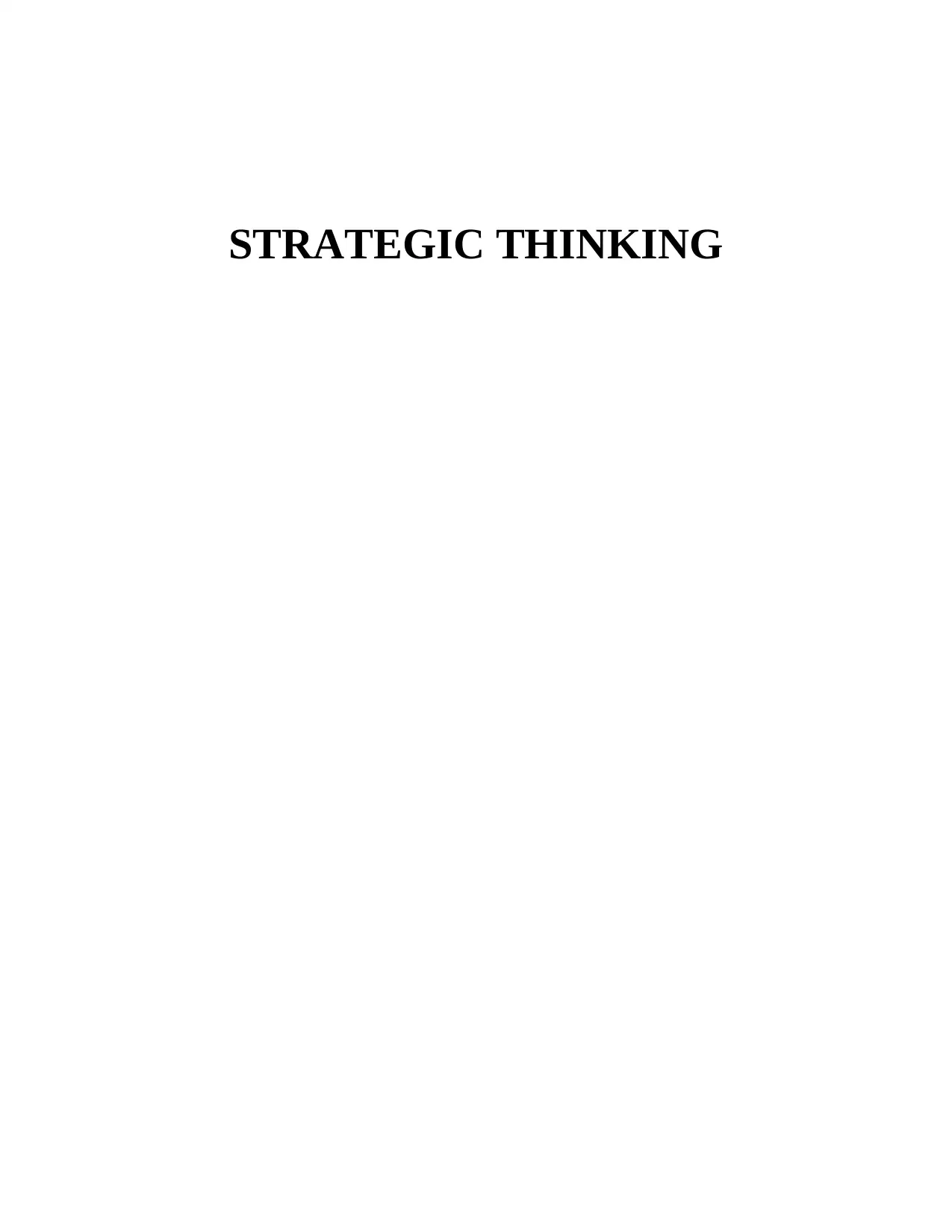
STRATEGIC THINKING
Paraphrase This Document
Need a fresh take? Get an instant paraphrase of this document with our AI Paraphraser
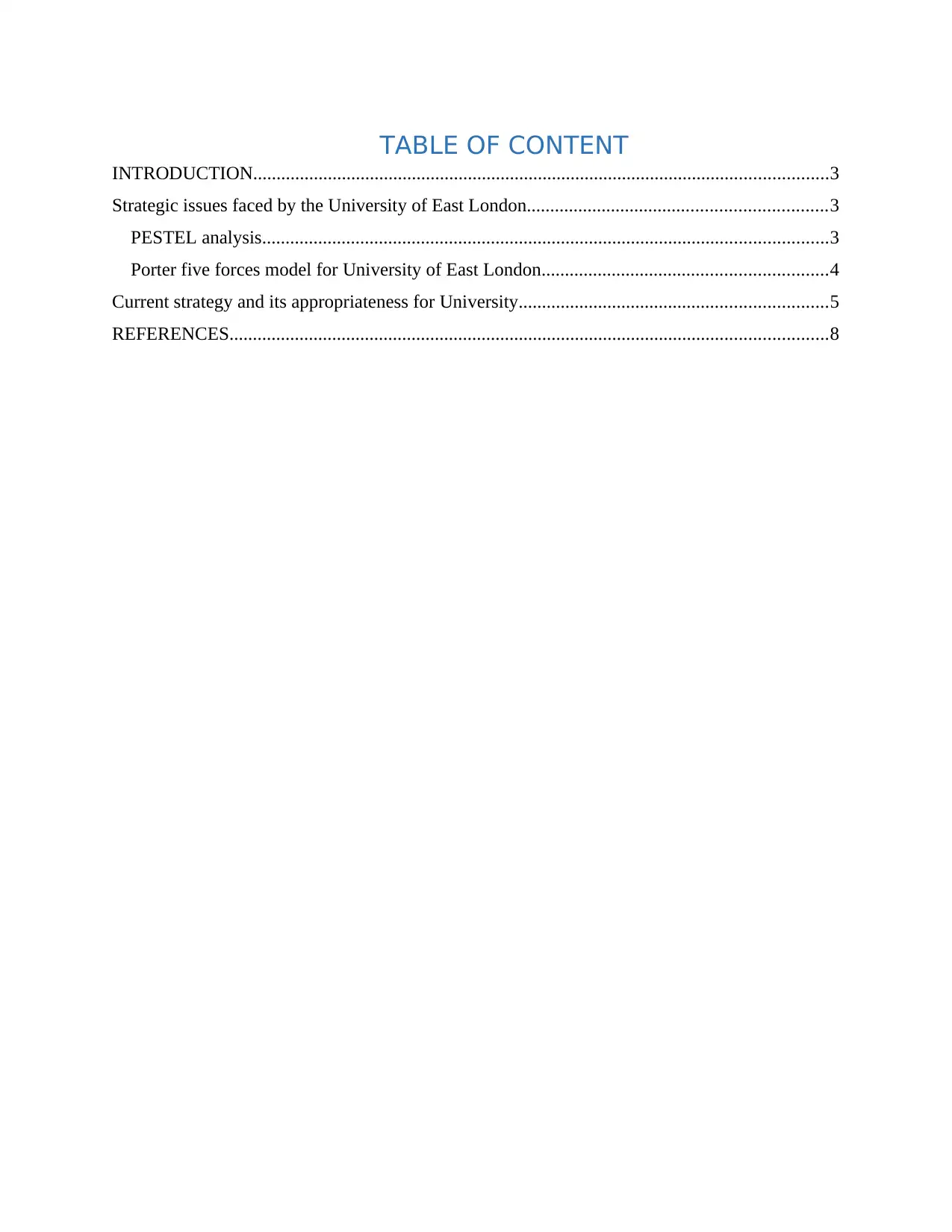
TABLE OF CONTENT
INTRODUCTION...........................................................................................................................3
Strategic issues faced by the University of East London................................................................3
PESTEL analysis.........................................................................................................................3
Porter five forces model for University of East London.............................................................4
Current strategy and its appropriateness for University..................................................................5
REFERENCES................................................................................................................................8
INTRODUCTION...........................................................................................................................3
Strategic issues faced by the University of East London................................................................3
PESTEL analysis.........................................................................................................................3
Porter five forces model for University of East London.............................................................4
Current strategy and its appropriateness for University..................................................................5
REFERENCES................................................................................................................................8
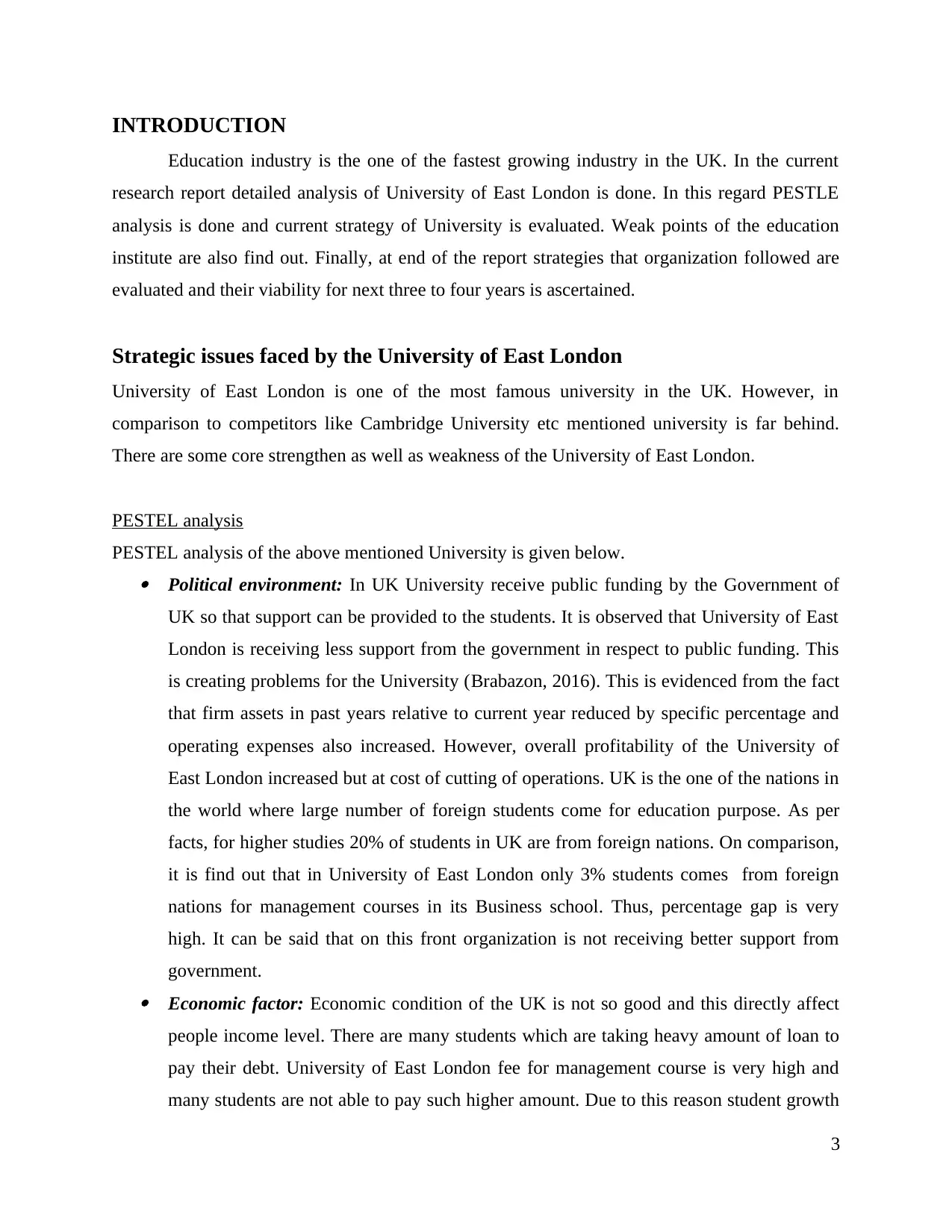
INTRODUCTION
Education industry is the one of the fastest growing industry in the UK. In the current
research report detailed analysis of University of East London is done. In this regard PESTLE
analysis is done and current strategy of University is evaluated. Weak points of the education
institute are also find out. Finally, at end of the report strategies that organization followed are
evaluated and their viability for next three to four years is ascertained.
Strategic issues faced by the University of East London
University of East London is one of the most famous university in the UK. However, in
comparison to competitors like Cambridge University etc mentioned university is far behind.
There are some core strengthen as well as weakness of the University of East London.
PESTEL analysis
PESTEL analysis of the above mentioned University is given below. Political environment: In UK University receive public funding by the Government of
UK so that support can be provided to the students. It is observed that University of East
London is receiving less support from the government in respect to public funding. This
is creating problems for the University (Brabazon, 2016). This is evidenced from the fact
that firm assets in past years relative to current year reduced by specific percentage and
operating expenses also increased. However, overall profitability of the University of
East London increased but at cost of cutting of operations. UK is the one of the nations in
the world where large number of foreign students come for education purpose. As per
facts, for higher studies 20% of students in UK are from foreign nations. On comparison,
it is find out that in University of East London only 3% students comes from foreign
nations for management courses in its Business school. Thus, percentage gap is very
high. It can be said that on this front organization is not receiving better support from
government. Economic factor: Economic condition of the UK is not so good and this directly affect
people income level. There are many students which are taking heavy amount of loan to
pay their debt. University of East London fee for management course is very high and
many students are not able to pay such higher amount. Due to this reason student growth
3
Education industry is the one of the fastest growing industry in the UK. In the current
research report detailed analysis of University of East London is done. In this regard PESTLE
analysis is done and current strategy of University is evaluated. Weak points of the education
institute are also find out. Finally, at end of the report strategies that organization followed are
evaluated and their viability for next three to four years is ascertained.
Strategic issues faced by the University of East London
University of East London is one of the most famous university in the UK. However, in
comparison to competitors like Cambridge University etc mentioned university is far behind.
There are some core strengthen as well as weakness of the University of East London.
PESTEL analysis
PESTEL analysis of the above mentioned University is given below. Political environment: In UK University receive public funding by the Government of
UK so that support can be provided to the students. It is observed that University of East
London is receiving less support from the government in respect to public funding. This
is creating problems for the University (Brabazon, 2016). This is evidenced from the fact
that firm assets in past years relative to current year reduced by specific percentage and
operating expenses also increased. However, overall profitability of the University of
East London increased but at cost of cutting of operations. UK is the one of the nations in
the world where large number of foreign students come for education purpose. As per
facts, for higher studies 20% of students in UK are from foreign nations. On comparison,
it is find out that in University of East London only 3% students comes from foreign
nations for management courses in its Business school. Thus, percentage gap is very
high. It can be said that on this front organization is not receiving better support from
government. Economic factor: Economic condition of the UK is not so good and this directly affect
people income level. There are many students which are taking heavy amount of loan to
pay their debt. University of East London fee for management course is very high and
many students are not able to pay such higher amount. Due to this reason student growth
3
You're viewing a preview
Unlock full access by subscribing today!
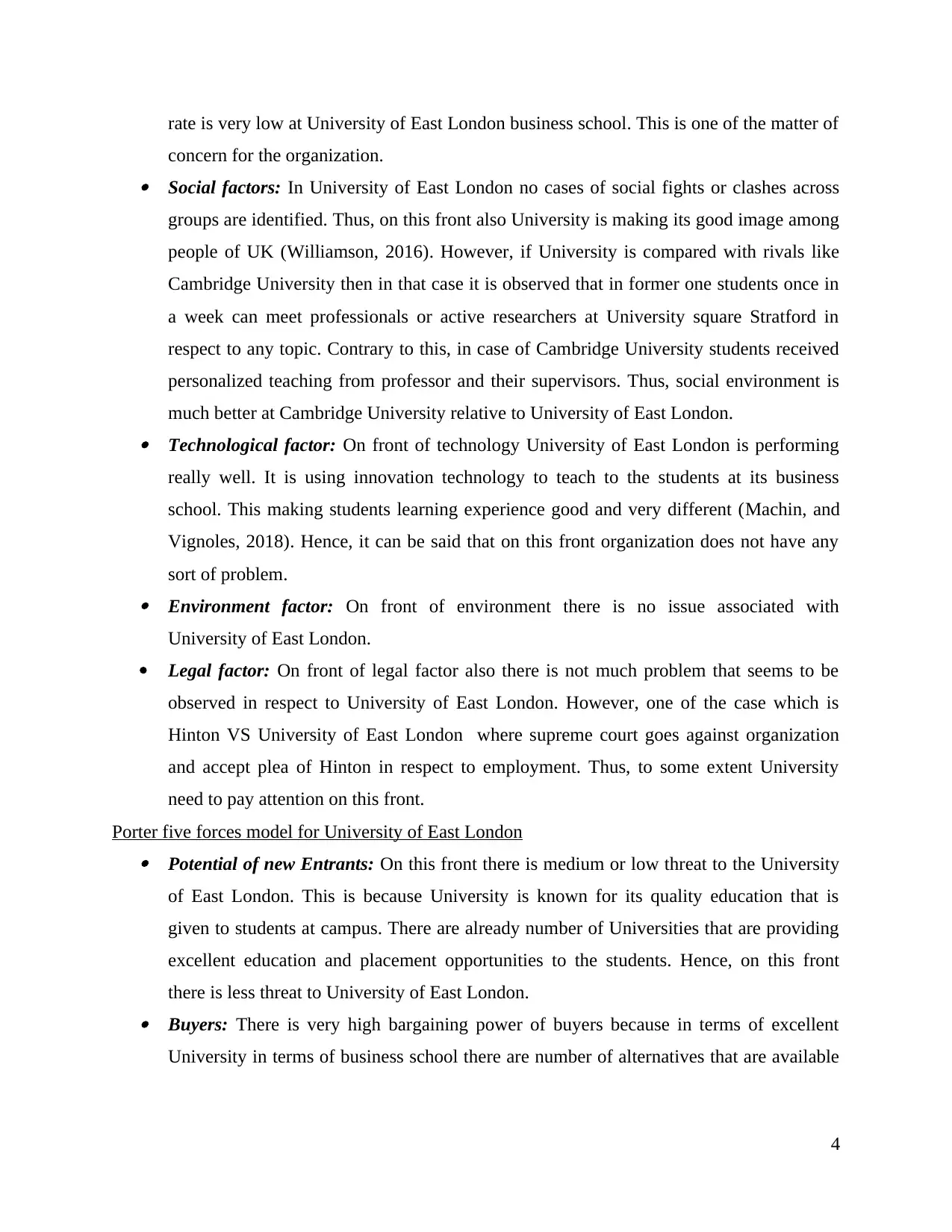
rate is very low at University of East London business school. This is one of the matter of
concern for the organization. Social factors: In University of East London no cases of social fights or clashes across
groups are identified. Thus, on this front also University is making its good image among
people of UK (Williamson, 2016). However, if University is compared with rivals like
Cambridge University then in that case it is observed that in former one students once in
a week can meet professionals or active researchers at University square Stratford in
respect to any topic. Contrary to this, in case of Cambridge University students received
personalized teaching from professor and their supervisors. Thus, social environment is
much better at Cambridge University relative to University of East London. Technological factor: On front of technology University of East London is performing
really well. It is using innovation technology to teach to the students at its business
school. This making students learning experience good and very different (Machin, and
Vignoles, 2018). Hence, it can be said that on this front organization does not have any
sort of problem. Environment factor: On front of environment there is no issue associated with
University of East London.
Legal factor: On front of legal factor also there is not much problem that seems to be
observed in respect to University of East London. However, one of the case which is
Hinton VS University of East London where supreme court goes against organization
and accept plea of Hinton in respect to employment. Thus, to some extent University
need to pay attention on this front.
Porter five forces model for University of East London Potential of new Entrants: On this front there is medium or low threat to the University
of East London. This is because University is known for its quality education that is
given to students at campus. There are already number of Universities that are providing
excellent education and placement opportunities to the students. Hence, on this front
there is less threat to University of East London. Buyers: There is very high bargaining power of buyers because in terms of excellent
University in terms of business school there are number of alternatives that are available
4
concern for the organization. Social factors: In University of East London no cases of social fights or clashes across
groups are identified. Thus, on this front also University is making its good image among
people of UK (Williamson, 2016). However, if University is compared with rivals like
Cambridge University then in that case it is observed that in former one students once in
a week can meet professionals or active researchers at University square Stratford in
respect to any topic. Contrary to this, in case of Cambridge University students received
personalized teaching from professor and their supervisors. Thus, social environment is
much better at Cambridge University relative to University of East London. Technological factor: On front of technology University of East London is performing
really well. It is using innovation technology to teach to the students at its business
school. This making students learning experience good and very different (Machin, and
Vignoles, 2018). Hence, it can be said that on this front organization does not have any
sort of problem. Environment factor: On front of environment there is no issue associated with
University of East London.
Legal factor: On front of legal factor also there is not much problem that seems to be
observed in respect to University of East London. However, one of the case which is
Hinton VS University of East London where supreme court goes against organization
and accept plea of Hinton in respect to employment. Thus, to some extent University
need to pay attention on this front.
Porter five forces model for University of East London Potential of new Entrants: On this front there is medium or low threat to the University
of East London. This is because University is known for its quality education that is
given to students at campus. There are already number of Universities that are providing
excellent education and placement opportunities to the students. Hence, on this front
there is less threat to University of East London. Buyers: There is very high bargaining power of buyers because in terms of excellent
University in terms of business school there are number of alternatives that are available
4
Paraphrase This Document
Need a fresh take? Get an instant paraphrase of this document with our AI Paraphraser
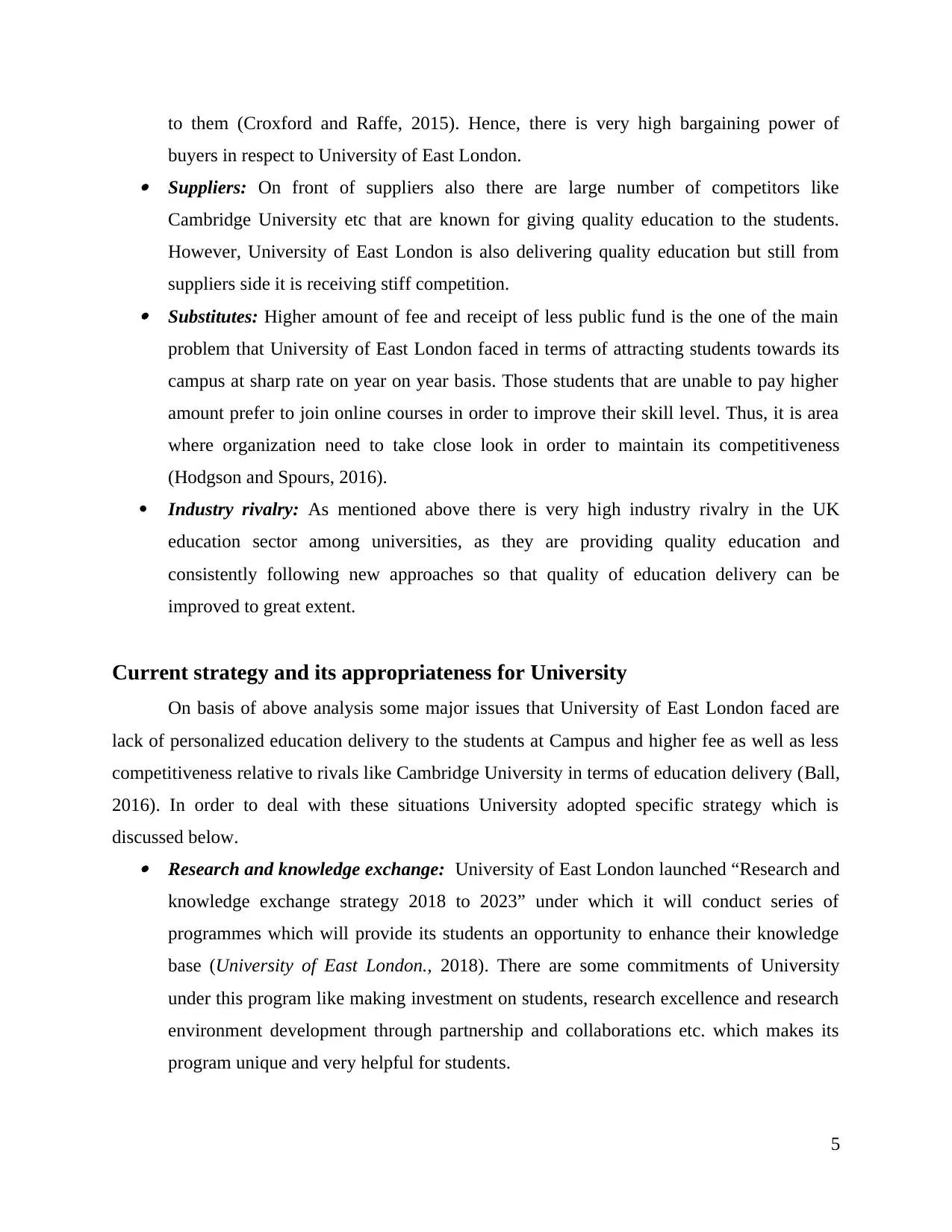
to them (Croxford and Raffe, 2015). Hence, there is very high bargaining power of
buyers in respect to University of East London. Suppliers: On front of suppliers also there are large number of competitors like
Cambridge University etc that are known for giving quality education to the students.
However, University of East London is also delivering quality education but still from
suppliers side it is receiving stiff competition. Substitutes: Higher amount of fee and receipt of less public fund is the one of the main
problem that University of East London faced in terms of attracting students towards its
campus at sharp rate on year on year basis. Those students that are unable to pay higher
amount prefer to join online courses in order to improve their skill level. Thus, it is area
where organization need to take close look in order to maintain its competitiveness
(Hodgson and Spours, 2016).
Industry rivalry: As mentioned above there is very high industry rivalry in the UK
education sector among universities, as they are providing quality education and
consistently following new approaches so that quality of education delivery can be
improved to great extent.
Current strategy and its appropriateness for University
On basis of above analysis some major issues that University of East London faced are
lack of personalized education delivery to the students at Campus and higher fee as well as less
competitiveness relative to rivals like Cambridge University in terms of education delivery (Ball,
2016). In order to deal with these situations University adopted specific strategy which is
discussed below. Research and knowledge exchange: University of East London launched “Research and
knowledge exchange strategy 2018 to 2023” under which it will conduct series of
programmes which will provide its students an opportunity to enhance their knowledge
base (University of East London., 2018). There are some commitments of University
under this program like making investment on students, research excellence and research
environment development through partnership and collaborations etc. which makes its
program unique and very helpful for students.
5
buyers in respect to University of East London. Suppliers: On front of suppliers also there are large number of competitors like
Cambridge University etc that are known for giving quality education to the students.
However, University of East London is also delivering quality education but still from
suppliers side it is receiving stiff competition. Substitutes: Higher amount of fee and receipt of less public fund is the one of the main
problem that University of East London faced in terms of attracting students towards its
campus at sharp rate on year on year basis. Those students that are unable to pay higher
amount prefer to join online courses in order to improve their skill level. Thus, it is area
where organization need to take close look in order to maintain its competitiveness
(Hodgson and Spours, 2016).
Industry rivalry: As mentioned above there is very high industry rivalry in the UK
education sector among universities, as they are providing quality education and
consistently following new approaches so that quality of education delivery can be
improved to great extent.
Current strategy and its appropriateness for University
On basis of above analysis some major issues that University of East London faced are
lack of personalized education delivery to the students at Campus and higher fee as well as less
competitiveness relative to rivals like Cambridge University in terms of education delivery (Ball,
2016). In order to deal with these situations University adopted specific strategy which is
discussed below. Research and knowledge exchange: University of East London launched “Research and
knowledge exchange strategy 2018 to 2023” under which it will conduct series of
programmes which will provide its students an opportunity to enhance their knowledge
base (University of East London., 2018). There are some commitments of University
under this program like making investment on students, research excellence and research
environment development through partnership and collaborations etc. which makes its
program unique and very helpful for students.
5
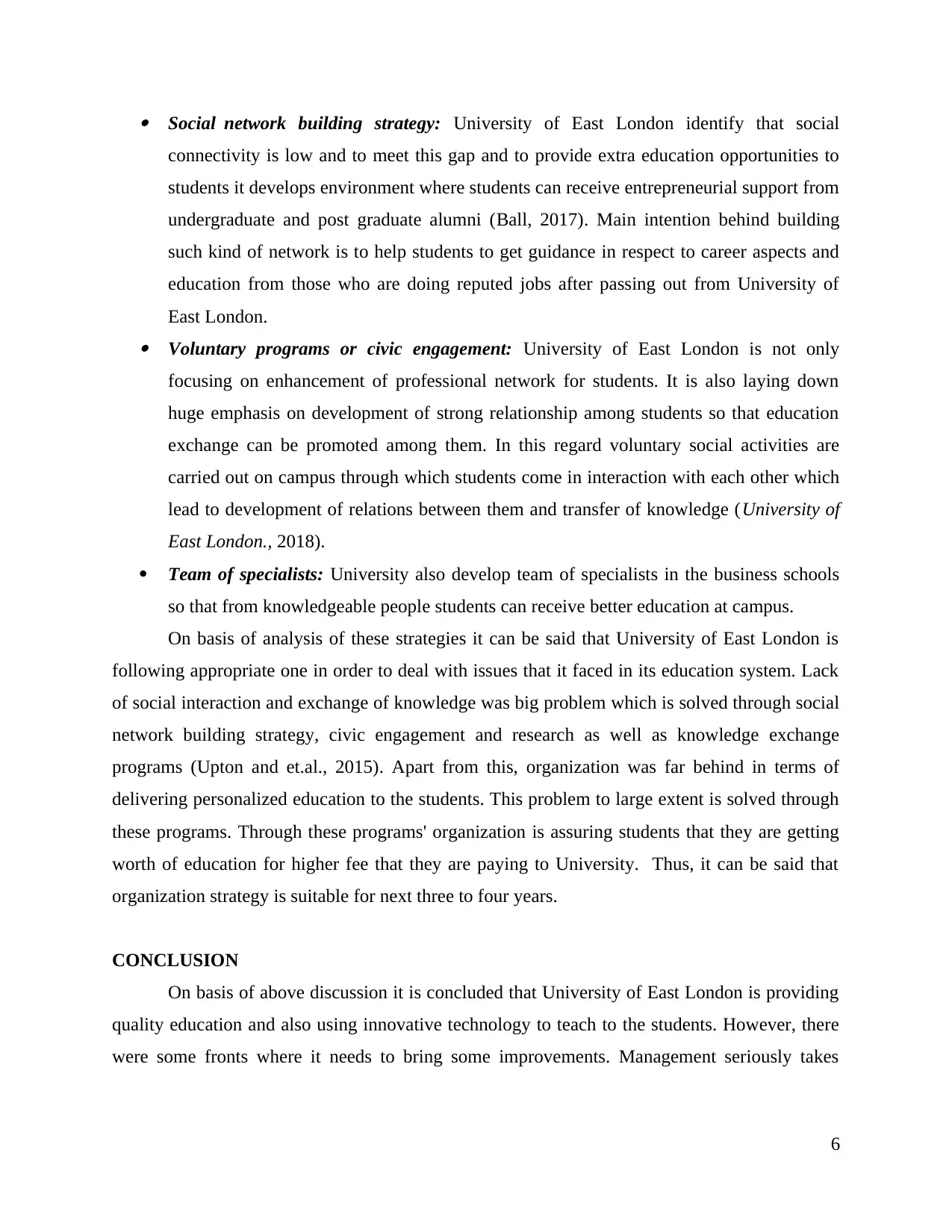
Social network building strategy: University of East London identify that social
connectivity is low and to meet this gap and to provide extra education opportunities to
students it develops environment where students can receive entrepreneurial support from
undergraduate and post graduate alumni (Ball, 2017). Main intention behind building
such kind of network is to help students to get guidance in respect to career aspects and
education from those who are doing reputed jobs after passing out from University of
East London. Voluntary programs or civic engagement: University of East London is not only
focusing on enhancement of professional network for students. It is also laying down
huge emphasis on development of strong relationship among students so that education
exchange can be promoted among them. In this regard voluntary social activities are
carried out on campus through which students come in interaction with each other which
lead to development of relations between them and transfer of knowledge (University of
East London., 2018).
Team of specialists: University also develop team of specialists in the business schools
so that from knowledgeable people students can receive better education at campus.
On basis of analysis of these strategies it can be said that University of East London is
following appropriate one in order to deal with issues that it faced in its education system. Lack
of social interaction and exchange of knowledge was big problem which is solved through social
network building strategy, civic engagement and research as well as knowledge exchange
programs (Upton and et.al., 2015). Apart from this, organization was far behind in terms of
delivering personalized education to the students. This problem to large extent is solved through
these programs. Through these programs' organization is assuring students that they are getting
worth of education for higher fee that they are paying to University. Thus, it can be said that
organization strategy is suitable for next three to four years.
CONCLUSION
On basis of above discussion it is concluded that University of East London is providing
quality education and also using innovative technology to teach to the students. However, there
were some fronts where it needs to bring some improvements. Management seriously takes
6
connectivity is low and to meet this gap and to provide extra education opportunities to
students it develops environment where students can receive entrepreneurial support from
undergraduate and post graduate alumni (Ball, 2017). Main intention behind building
such kind of network is to help students to get guidance in respect to career aspects and
education from those who are doing reputed jobs after passing out from University of
East London. Voluntary programs or civic engagement: University of East London is not only
focusing on enhancement of professional network for students. It is also laying down
huge emphasis on development of strong relationship among students so that education
exchange can be promoted among them. In this regard voluntary social activities are
carried out on campus through which students come in interaction with each other which
lead to development of relations between them and transfer of knowledge (University of
East London., 2018).
Team of specialists: University also develop team of specialists in the business schools
so that from knowledgeable people students can receive better education at campus.
On basis of analysis of these strategies it can be said that University of East London is
following appropriate one in order to deal with issues that it faced in its education system. Lack
of social interaction and exchange of knowledge was big problem which is solved through social
network building strategy, civic engagement and research as well as knowledge exchange
programs (Upton and et.al., 2015). Apart from this, organization was far behind in terms of
delivering personalized education to the students. This problem to large extent is solved through
these programs. Through these programs' organization is assuring students that they are getting
worth of education for higher fee that they are paying to University. Thus, it can be said that
organization strategy is suitable for next three to four years.
CONCLUSION
On basis of above discussion it is concluded that University of East London is providing
quality education and also using innovative technology to teach to the students. However, there
were some fronts where it needs to bring some improvements. Management seriously takes
6
You're viewing a preview
Unlock full access by subscribing today!

problems and formulate number of strategies which seems to prove effective for it in upcoming
years.
7
years.
7
Paraphrase This Document
Need a fresh take? Get an instant paraphrase of this document with our AI Paraphraser
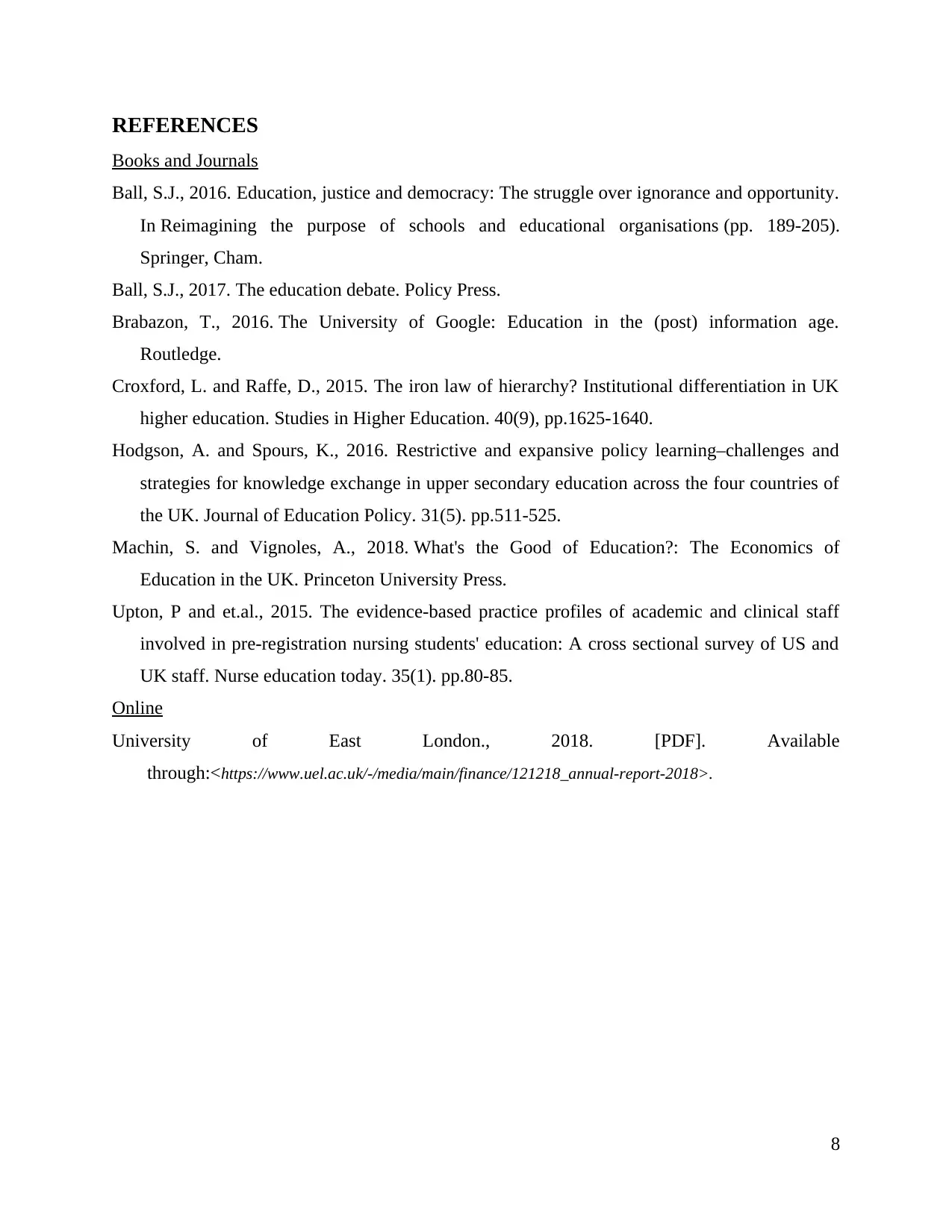
REFERENCES
Books and Journals
Ball, S.J., 2016. Education, justice and democracy: The struggle over ignorance and opportunity.
In Reimagining the purpose of schools and educational organisations (pp. 189-205).
Springer, Cham.
Ball, S.J., 2017. The education debate. Policy Press.
Brabazon, T., 2016. The University of Google: Education in the (post) information age.
Routledge.
Croxford, L. and Raffe, D., 2015. The iron law of hierarchy? Institutional differentiation in UK
higher education. Studies in Higher Education. 40(9), pp.1625-1640.
Hodgson, A. and Spours, K., 2016. Restrictive and expansive policy learning–challenges and
strategies for knowledge exchange in upper secondary education across the four countries of
the UK. Journal of Education Policy. 31(5). pp.511-525.
Machin, S. and Vignoles, A., 2018. What's the Good of Education?: The Economics of
Education in the UK. Princeton University Press.
Upton, P and et.al., 2015. The evidence-based practice profiles of academic and clinical staff
involved in pre-registration nursing students' education: A cross sectional survey of US and
UK staff. Nurse education today. 35(1). pp.80-85.
Online
University of East London., 2018. [PDF]. Available
through:<https://www.uel.ac.uk/-/media/main/finance/121218_annual-report-2018>.
8
Books and Journals
Ball, S.J., 2016. Education, justice and democracy: The struggle over ignorance and opportunity.
In Reimagining the purpose of schools and educational organisations (pp. 189-205).
Springer, Cham.
Ball, S.J., 2017. The education debate. Policy Press.
Brabazon, T., 2016. The University of Google: Education in the (post) information age.
Routledge.
Croxford, L. and Raffe, D., 2015. The iron law of hierarchy? Institutional differentiation in UK
higher education. Studies in Higher Education. 40(9), pp.1625-1640.
Hodgson, A. and Spours, K., 2016. Restrictive and expansive policy learning–challenges and
strategies for knowledge exchange in upper secondary education across the four countries of
the UK. Journal of Education Policy. 31(5). pp.511-525.
Machin, S. and Vignoles, A., 2018. What's the Good of Education?: The Economics of
Education in the UK. Princeton University Press.
Upton, P and et.al., 2015. The evidence-based practice profiles of academic and clinical staff
involved in pre-registration nursing students' education: A cross sectional survey of US and
UK staff. Nurse education today. 35(1). pp.80-85.
Online
University of East London., 2018. [PDF]. Available
through:<https://www.uel.ac.uk/-/media/main/finance/121218_annual-report-2018>.
8

9
You're viewing a preview
Unlock full access by subscribing today!

10
1 out of 10
Related Documents
Your All-in-One AI-Powered Toolkit for Academic Success.
+13062052269
info@desklib.com
Available 24*7 on WhatsApp / Email
![[object Object]](/_next/static/media/star-bottom.7253800d.svg)
Unlock your academic potential
© 2024 | Zucol Services PVT LTD | All rights reserved.





